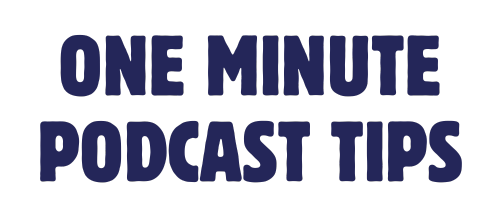Episode 92
Why You Should Use the Correct LUFS Setting for Your Podcast
When it comes to the listening experience of your podcast followers, LUFS plays a huge role in making it as enjoyable as possible. So what is LUFS and why is it important for your podcast?
Additional reading and listening:
- What Are LUFS? The Complete Guide
- How to do loudness: the LUFS and LKFS FAQ for podcasters
- LUFS vs dB: What’s the Difference and Why Does It Matter? - Produce Like A Pro
Products I Use for One Minute Podcast Tips
Note: these contain affiliate links, so I may get a small percentage of any product you buy/use when using my link.
My equipment:
- Shure SM7B dynamic mic
- TZ Audio Stellar X2 condenser mic
- Rodecaster Pro II audio production studio
- Sony MDR-7506 Studio Monitor Headphones
- JOBY Wavo Boom Arm
- Elgato Wave Mic Arm Low Profile
Recommended resources:
Leave a review:
This podcast uses the following third-party services for analysis:
OP3 - https://op3.dev/privacy
Transcript
(clapping)
Speaker:You're listening to One Minute Podcast Tips.
Speaker:I'm your host, Danny Brown.
Speaker:And each episode brings you snack-sized tips
Speaker:to be a better podcaster.
Speaker:And if you enjoy the show,
Speaker:you can now support with a one-off donation
Speaker:at oneminutepodcasttips.com/support.
Speaker:And now, this week's episode.
Speaker:When it comes to the listening experience of your podcast,
Speaker:it's important to understand LUFS
Speaker:and why you need to use the correct one.
Speaker:So what is LUFS?
Speaker:Well LUFS stands for Loudness Units Full Scale
Speaker:and basically it's a standardised way of measuring loudness.
Speaker:Now I won't get too technical on this
Speaker:but basically there's two types of LUFS,
Speaker:short term and integrated.
Speaker:Short term gives us a peak reading
Speaker:of the last three seconds of audio
Speaker:while integrated is an average of the whole audio mix.
Speaker:And it's how we measure loudness for film,
Speaker:music streaming, radio and podcasting.
Speaker:To get an idea of how important LUFS is,
Speaker:ask yourself if you've ever listened to an episode
Speaker:and the ads have been much louder than the episode audio itself or vice versa.
Speaker:Ideally you want every part of your episode at the same level.
Speaker:Whether that's you and a guest, your ads, your intro, your outro etc.
Speaker:It makes it a lot more comfortable to listen back to.
Speaker:Generally there are two settings to work by.
Speaker:-16 LUFS for stereo and -19 LUFS for mono.
Speaker:Now a lot of editing software has LUFS settings built in.
Speaker:I use Hindenburg Pro for example and when I export the audio I can set it to -16.
Speaker:and I do this for all my ads, sponsor messages, intro, outro, music and more.
Speaker:This ensures that every part of my audio is exactly the same level.
Speaker:There's some great resources for LUFS,
Speaker:including a detailed explanation of what they are and how to use them,
Speaker:and I'll leave links to those in the episode show notes,
Speaker:so be sure to check them out too.
Speaker:Until the next time, happy podcasting.
Speaker:If you're enjoying One Minute Podcast Tips,
Speaker:leave a review at oneminutepodcasttips.com/review
Speaker:and help others like you find the show too.
Speaker:Until the next time, happy podcasting.
Speaker:(upbeat music)
Speaker:(upbeat music)






